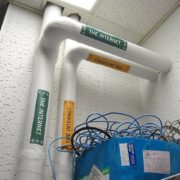How to Get an A+ in Network Security for Your School
Schools are responsible for not only the education and well-being of students, but also the protection of private data pertaining to everything from health reports and psychological profiles to social security numbers and contact addresses.
As the guardians of so much information, schools should always focus on superior network security.
We’ve come up with three major network security features you can implement in your school to shore up potential ongoing vulnerabilities.
1.) Powerful Passwords
For many students, creating passwords at school can seem like another exercise in creativity. Do any kind of basic survey and you’ll find ineffective passwords that range from the doomed “Password1234” to the sarcastic “JohnnySucks.”
In addition, many teachers lack the technological prowess to instruct students in proper password complexity.
Think of an inadequate password’s effect on your network security like this: You can have an adequate lock on your front door, but if you’re leaving the key underneath the doormat it doesn’t do much good. It’s too easy.
A lazy password is a hacker’s best friend.
The most basic way to secure your network is to create longer, more complex passwords. Complicated passwords should include a mix of upper and lowercase letters, numbers, symbols, and emoticons.
Business Insider suggests creating a password by using the “full-sentence technique.” Start with a single sentence, like “I bought salmon for $20 at the grocery store.” Then, just use the first letter of every word and add in the symbols.
So, the resulting phrase “Ibsf$20atgs” would be a random password that you can remember just by memorizing one sentence.
The longer the sentence, the better, because hackers and/or hacking programs have to work harder when passwords are longer.
Utilizing a password manager to keep track of your stockade of complex passwords is a great way to combine the ease of accessing your various web services as if you had one password with the security that password complexity and variety provide.
Related: The Best Password Managers of 2018
2.) Additional User Authentication
A school network faces a huge challenge in that it is often in contact with a countless variety of devices. Not only do the students and faculty have access to the network via district-provided hardware, but the continued growth of the BYOD (bring your own device) trend means that students are connecting through personal phones, tablets, and laptops created by different brands, which also run on different operating systems.
To further increase security, we suggest implementing multi-factor authentication (MFA). In a nutshell, MFA is the process of identifying an online user by validating two or more claims presented by the user, each from a different category of factors.
We already use multi-factor authentication in the real world. One example is when you go to apply for a passport. The passport application requires a minimum of two forms of identification, such as a state driver’s license and a birth certificate. MFA for your network works the same way.
Your school network should establish a multi-factor authentication process that involves:
a.) The complex password we mentioned earlier.
b.) Something the user has on hand, like a cell phone or tablet.
c.) Biometrics like a fingerprint or optical or voice recognition software.
When the MFA process involves a device on hand, there is an inherent check-and-balance to the system, allowing the network to authenticate the device being used.
When the MFA process involves biometrics, your network can cross-reference requested access with the biometric data on hand.
Whichever way you and your managed service provider choose to utilize multi-factor authentication, it is guaranteed to make it more difficult for intruders to gain access to your network, and to keep your data more secure.
3.) Updated Infrastructure
Many schools have hundreds of computers and other web-accessible devices operating on their networks. And often, the network itself is comprised of legacy equipment such as outdated servers, computers, and other devices.
Often this outdated infrastructure has security flaws. Or else it can no longer stand up to the progressive threats of malware and ransomware. It can also be chock full of bottlenecks and bandwidth issues that slow performance across the network. But that’s an issue for another post.
Related: Why Traditional Firewalls Can’t Keep up With Modern Trends
For many schools, a migration to the cloud is the best way to shore up vulnerabilities while simultaneously fixing the performance problems plaguing their network.
Rather than making a high capital investment in replacing the vulnerable outdated equipment, switching to cloud computing means taking on a lower monthly cost for superior performance and security.
It can even bring about more powerful web filtering tools that block access to harmful or inappropriate sites across the network.
Report Card Time
Do your school passwords pass the test? Are your students and faculty using multi-factor authentication to ensure the safety of your network? And is that network up to modern security standards? If so, you pass with flying colors. If not, it’s definitely time to chat about how to get your grades up.











